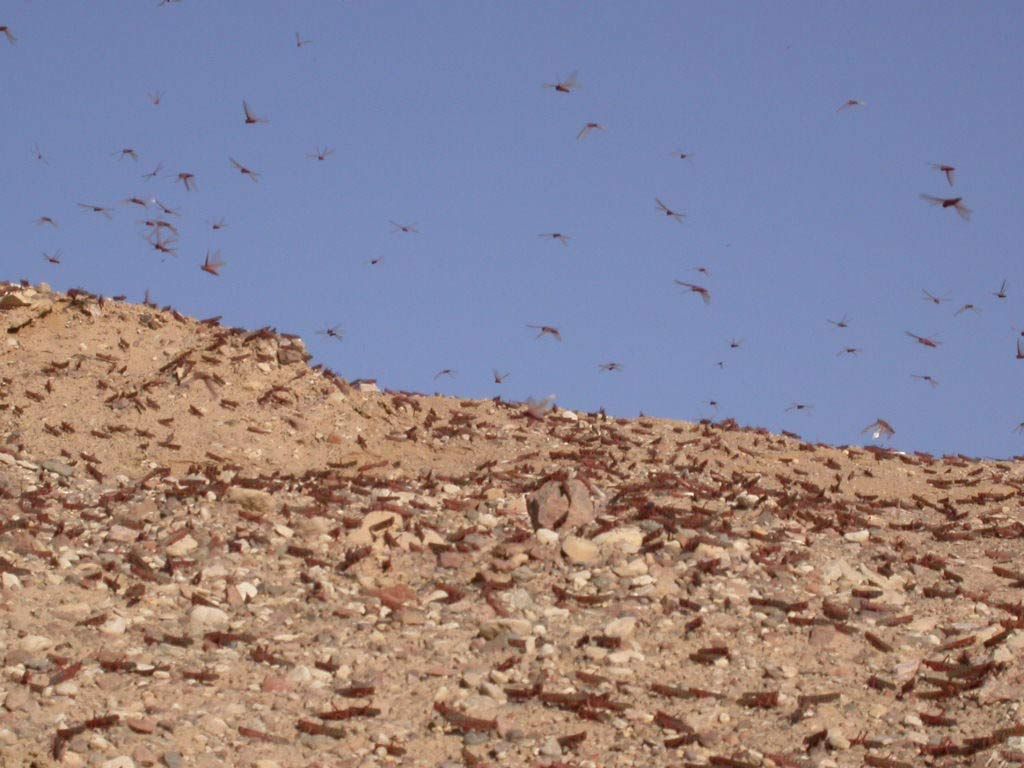Israel Escapes Locust Plague — For Now

MITZPE RAMON, Israel — A menacing swarm of locusts that entered southern Israel earlier this week has been largely smitten, according to the Israeli government and local reports. But some of the insects' ilk may be back later this week.
Officials sprayed the flying insects with pesticide early this morning (March 6), greatly reducing the number of living, flying insects, according to a statement from the Ministry of Agriculture and Rural Development.
However, there's a "moderate risk" that another, small swarm could reach this region, in Israel's Negev Desert, later this week or on the weekend, said Keith Cressman, a senior locust-forecasting officer in Rome for the Food and Agriculture Organization (FAO) of the United Nations.
The desert locusts, whose scientific name is Schistocerca gregaria, arrived a couple weeks before Passover, the weeklong festival that recounts the biblical exodus of the Jewish people from Egypt. According to the Bible, swarms of locusts were the eighth plague sent into ancient Egypt as a punishment for suppressing the Jews, said Hendrik Bruins, a researcher who studies the archaeology and environmental aspects of desert peoples, at Israel's Ben-Gurion University of the Negev.
"This [current swarm] fits very well with the seasonal timing of the exodus in the bible," Bruins said.
But could the plague be a divine punishment this time around? "This, we cannot say," Bruins told LiveScience. "Because there have been so many plagues throughout history, not every locust plague can be classified in that way," he said, laughing. [See Images of the Desert Locust Swarms]
Gregarious grasshoppers
Sign up for the Live Science daily newsletter now
Get the world’s most fascinating discoveries delivered straight to your inbox.
All locusts are grasshoppers, or in the grasshopper family, but not all grasshoppers are locusts, said Amir Ayali, a researcher at Tel Aviv University. About 15 species of grasshoppers can be classified as locusts, essentially meaning they can fly and create swarms. The creatures are usually solitary and avoid each other, but in the right conditions, they congregate in large groups, exhibiting what is called a "gregarious" behavior, Ayali said.
The current swarm originated in southeastern Egypt and northeastern Sudan, despite efforts by these countries to control the insects' populations, Cressman said. The animals thrive in relatively wet conditions, and the locusts moved on once the area started to dry out in early February, he continued. By March 2, they had reached Cairo, buffeted by winds out of the south. There were many thousands of locusts in the swarms that have arrived in southern Israel, but the exact number is unclear, according to officials.
Locusts are passive fliers, and can't get far flying into the breeze; however, under the right conditions, they can fly up to 90 miles (150 kilometers) per day, Cressman said.
On March 4, winds from the west brought a small swarm into Israel's Negev, and another group arrived the same way the next day (March 5), Cressman added. Now, however, the insects have been sprayed, and the wind has shifted, now blowing out of the northeast, greatly reducing the threat the insects pose. The creatures are also "less active and voracious than normal because they have already traveled quite some distance," Cressman said. [In Photos: Nature's Biggest Pests]
However, a small swarm could reach northeastern Egypt and the Negev on Friday or Saturday, Cressman said. This morning, officials warned Israel, Jordan and Egypt to take necessary measures, he said.
Zapping locusts
The only way to deal with large locust outbreaks is to spray them with pesticides, Cressman said, a process that "has become increasingly safer and more environmentally friendly over the years." Persistent pesticides (that don't break down after spraying) are no longer used, having been replaced with varieties that evaporate after 24 hours, he said. The chemicals are also sprayed directly on locusts instead of on vegetation or the ground, are only used in small quantities and are deployed by highly trained specialists, he said.
Such specialists increasingly rely on a new family of bio-pesticides, such as a chemical called Green Muscle that comes from a naturally occurring fungus that only attacks locusts. In particular, officials use these bio-pesticides in sensitive areas like nature reserves, he said.
The FAO warned Israel a couple days ahead of time that swarms were likely, and the country "immediately mobilized teams [and] resources, and informed farmers and other parties so they were prepared for the locusts," Cressman said.
The locusts may not be all bad, however. The locust is the only kosher insect, meaning it is acceptable to eat under Jewish law, Bruins said. "I've never eaten them, but they seem to be quite tasty."
Cressman, however, has sampled the critters. "I have eaten desert locusts roasted on the fire, boiled, dried and fried — rather a poor man's version of shrimp," he said.
Generally, however, the locusts are the ones doing the eating. A swarm the size of Cairo — which is not unusual for the desert locust — could, in one day, eat the same amount of food as 15 million people could consume, Cressman said. That's about twice the population of Cairo, he added.
This article was generated during a reporting trip paid for by Ben-Gurion University.
Email Douglas Main at dmain@techmedianetwork.com or follow him @Douglas_Main. Follow us @livescience, Facebook or Google+.













